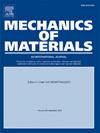Ab initio calculation of surface elasticity parameters in cubic crystalline films with surface point defects: Effects on SH wave propagation
IF 4.1
3区 材料科学
Q2 MATERIALS SCIENCE, MULTIDISCIPLINARY
引用次数: 0
Abstract
Elastic material surface and interface properties have non-negligible influences on the behavior of nano-sized elastic objects. Even though the concern and the need for the evaluation of surface properties were raised in 1876 by Gibbs, due to serious experimental and theoretical difficulties their measurements have remained idle till only recently. This paper offers a theoretical approach for an accurate evaluation of free surface energy density, surface layer relaxation, surface elastic constants, surface residual stresses, and surface mass density for the (100) and (111) planes of several non-magnetic cubic metals. Moreover, the analysis is extended to the surfaces where point defects, such as vacancies and substitutional impurity atoms, are present. The interaction of these point defects with surface is in particular important for irradiation and fracture phenomena. The present results are compared with the recent available experimental and theoretical data. For the sake of illustration of the importance of surface effects, the propagation of horizontally polarized shear waves (SH waves) in ultra-thin layers of only a few lattice parameters height will be studied. Utilizing the theoretically calculated surface parameters herein, the surface effects with and without the above-mentioned surface point defects will be examined in some details. Thus, the negative dispersion of SH waves within surface elasticity theory will be showcased quantitatively for various cubic crystals of interest. Moreover, the effects of the crystallographic orientations will also be examined in the presence and absence of surface point defects.
具有表面点缺陷的立方晶膜表面弹性参数的从头计算:对SH波传播的影响
弹性材料的表面和界面性质对纳米尺度弹性物体的行为具有不可忽视的影响。尽管吉布斯在1876年提出了对表面性质评估的关注和需要,但由于严重的实验和理论困难,直到最近,他们的测量才被搁置。本文为几种非磁性立方金属(100)和(111)面的自由表面能密度、表面层弛豫、表面弹性常数、表面残余应力和表面质量密度的精确评价提供了一种理论方法。此外,分析扩展到点缺陷,如空位和取代杂质原子,存在的表面。这些点缺陷与表面的相互作用对于辐照和断裂现象尤为重要。本文的结果与最近的实验和理论数据进行了比较。为了说明表面效应的重要性,我们将研究水平极化横波(SH波)在只有几个晶格参数高度的超薄层中的传播。利用本文理论计算的表面参数,详细分析了存在和不存在上述表面点缺陷的表面效应。因此,表面弹性理论中SH波的负色散将定量地展示各种感兴趣的立方晶体。此外,晶体取向的影响也将在存在和不存在表面点缺陷的情况下进行检查。
本文章由计算机程序翻译,如有差异,请以英文原文为准。
求助全文
约1分钟内获得全文
求助全文
来源期刊

Mechanics of Materials
工程技术-材料科学:综合
CiteScore
7.60
自引率
5.10%
发文量
243
审稿时长
46 days
期刊介绍:
Mechanics of Materials is a forum for original scientific research on the flow, fracture, and general constitutive behavior of geophysical, geotechnical and technological materials, with balanced coverage of advanced technological and natural materials, with balanced coverage of theoretical, experimental, and field investigations. Of special concern are macroscopic predictions based on microscopic models, identification of microscopic structures from limited overall macroscopic data, experimental and field results that lead to fundamental understanding of the behavior of materials, and coordinated experimental and analytical investigations that culminate in theories with predictive quality.
 求助内容:
求助内容: 应助结果提醒方式:
应助结果提醒方式:


